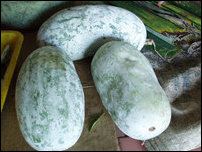Know the Etymology: 290
Place Name of the Day: Saturday, 21 September 2013
Puhul-kotuwa
புஹுல் கொ[ட்]டுவ
Puhul koṭuvaPuhul+kotuwa
The pumpkin enclosure
| Puhul |
Pumpkin gourd, Ash-pumpkin (Sinhala); Puhul-gediya: Ash-pumpkin, Benincasa cerifera (Sinhala); Poosuni, Poosani, Poosani, Poosini: Ash-pumpkin, Pumpkin, Benincasa cerifera, Cucurbita pepo, Cucurbita moschata, Cucurbita maxima; the last three are probably introduced varieties (Tamil, Thirumoolar, 2869); Poo-chunai: The flowery (creeper) with pustules or prickles; Chunai: Pustules or prickle as in leaves, stalks, etc., which is found in the pumpkin leaves and stalks (Etymology for Poosuni traced by MTL); Paakal, Paaval: Balsam pear, bitter gourd, Momordica charantia (Tamil, Aka:naanooru 15:4, DED 4045); Paaval: Momordica charantia (Malayalam, DED 4045); Haagal, Haagala: Momordica charantia (Kannada, DED 4045); Probably from Paa, spreading (Tamil, DED 4088)
|
| Pus |
Mildew, fungus forming on things in a dump place, mould (Sinhala); Poognchu, Poognchanam, Poognchalam: Mildew, mould (Tamil, DED 4357); Pookka: To become mouldy (Malayalam, DED 4357); Pooppu: Mould (Malayalam, DED 4357); Booju, Booje, Boosi, Boosu: Mould, mildew, mustiness (Kannada, DED 4357); Booju, Boocu, Booci, Poognke: Mould, mildew (Tulu, DED 4357); Booju: Mould, mildew (Telugu, DED 4357)
|
| Puhu |
Hollow, applied to fruits without kernel (Sinhala); Pus: (adjective) Blank, empty, barren, vacant (Sinhala); Pussa; Empty, barren, hollow, fruit without kernel (Sinhala); Pokku: Hollow (Tamil, DED 4452).
|
| Kotuwa |
(singular), Kotu (plural): Enclosure, fortress, castle (Sinhala); Kotu: (adjective) Surrounded, fenced in (Sinhala); Kodu: Curved (Tamil, DED 2054a); Koadu: Stronghold (Tamil, DED 2207); Koaddai: Fort, castle (Tamil, DED 2207a)
|
Puhul in Sinhala means the pumpkin gourd or ash-pumpkin. The Sinhala word corresponds to Poosuni, Poosani, Poosani and Poosini in Tamil, meaning the same (S/ H change).
Among the varieties of pumpkin that are cultivated in the island today, the ash-pumpkin (Benincasa cerifera) is the native crop of South Asia. The others are often called Parangki-poosani, meaning that they are foreign.

Ash-pumpkin, Benincasa cerifera [Image courtesy: Ai Lee, simboh.blogspot.no]
The ash-pumpkin is also called in English as the ash-gourd, winter gourd or wax gourd, because of the conspicuous skin of its fruit that is ashy, waxy, snowy or mildew-like. In Tamil, it is also known as Neettup-poosani or Chaampal-poosani, both meaning that it is ashy.
The ash-pumpkin is the one that is used in both the Tamil and Sinhala folk rituals, confirming that this is the native variety.
Puhul-kapanawaa (cutting a ash pumpkin) is a folk ritual in Sinhala, in which the ash-pumpkin is offered to demons. Similar ritual is found in Tamil culture also, in which cut halves of ash-pumpkin, smeared with vermillion are kept at a junction as an offering to demons in order to get rid of evil. In other similar rituals an ash-pumbkin is hanged at the front of a newly built house to ward off evil eye, and in the case of a newly acquired vehicle, it is first made to smash an ash pumpkin.
The ash-pumpkin is also a traditional vegetable in South Asia.
Both the words Puhul and Poosani for ash-pumpkin have no convincing cognates in Indo-Aryan.
The Madras Tamil lexicon traces the etymology of Poosani to Poo-chunai: Poo meaning flower and Chunai is the pustules or prickles that are typically found in the pumpkin leaves and stalks. They are found in an un-matured ash-pumpkin fruit also.
However, a careful study of the Sinhala and Tamil cognates and related words would show that the ash-pumpkin has got the names because of its mildew or fungus-like skin.
Poognchu, Poognchanam and Poognchalam in Tamil that could have rendered the term Poosuni, Poosani, Poosani etc., and Pus that could become Puhu in Sinhala, mean mildew, fungus or mould found on anything. Also note the other Dravidian cognates, especially Boosu in Kannada and Boocu in Tulu meaning mildew (DED 4357).
The boxes above deal with other possible cognates too, but the cognates related to mildew or fungus seem to be the most appropriate ones in explaining the etymology of Puhul/ Poosuni. Note the Tamil/ Dravidian cognate Poognchalam to explain the L in Puhul.
* * *Example for the use of the word Poosani in early Tamil:Puzhuthiyaith thoa'ndinean poosa'ni pooththathu (Thirumoolar, 2870, c. 56 century CE)
புழுதியைத் தோண்டினேன் பூசணி பூத்தது (திருமூலர், 2870, c. 56 century CE)
I dug the ashy earth and the pumpkin blossomed (the verse has an abstract religious meaning)
* * *Kotuwa means an enclosure, fortress or castle in Sinhala. The adjective form Kotu means a place surrounded or fenced in.
Kotuwa, in the context of the place name Puhul-kotuwa, means an enclosed or fenced garden.
See column on Pita-kotuwa for etymological discussions on the term.
* * *Puhul-kotuwa is a place in Buttala division of Moneragala district
* * *Some related place names:Puhul-yaaya: The expanse of pumpkins; Ambalanthota division, Hambantota district
Puhula-hena: The slash and burn field where pumpkins are cultivated; Welipitiya division, Matara district; Mahawewa division, Puththalam district
Puhul-wælla: The sandy place of pumpkins; KirindaPuhulwella division, Matara district
Puhule-wewa: The tank to cultivate pumpkins; Horowpothana division, Anuradhapura district
Puhul-watta: The Pumpkin garden; Passara division, Badulla district
Puhule-gama: The village of pumpkins; Warakapola division, Kegalle district
Puhul-pola: The pumpkin market or the open space for cultivating pumpkins; Welimada division, Badulla district
Kande-puhul-pola: The hill part of the Puhul-pola village; Welimada division, Badulla district
First published: Saturday, 21 September 2013, 08:54
Previous columns:







